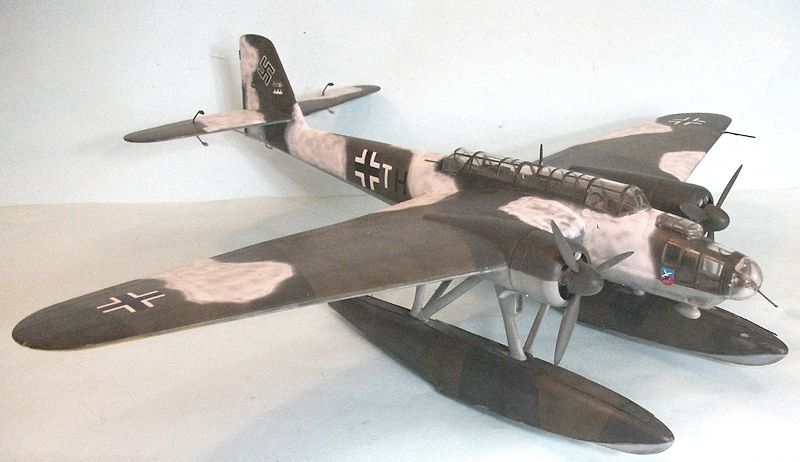
Special Hobby 1/48 He-115
| KIT #: | 48110 |
| PRICE: | 9775 yen at www.hlj.com |
| DECALS: | Three options |
| REVIEWER: | Tom Cleaver |
| NOTES: | Short run kit with photo etch |

| HISTORY |
The Heinkel He 115 was a three-seat seaplane, was used as a torpedo bomber and
for reconnaissance and minelaying.
The first prototype flew in August 1937,and the He 115 was selected over the Ha
140 early in 1938. The first
prototype set a series of international records for floatplanes over 1,000 km
(621 mi) and 2,000 km (1,243 mi) closed circuits at a speed of 328 km/h (204
mph).
Initial armament was two 7.92 mm MG 15s, one in the nose and one in the dorsal
position. They were later fitted
with a fixed forward-firing 15 mm or 20 mm MG 151 cannon, and two
rearward-firing 7.92 mm MG 17s in the engine nacelles.
The aircraft could carry the LTF 5 or LTF 6b torpedoes and SD 500 500 kg
(1,100 lb) or SC 250 250 kg (550 lb) bombs.
Initially,
the He-115s were used for minelaying in the English Channel and North Sea, but
proved vulnerable when intercepted due to their relatively low speed and light
armament. When the British began
sending convoys to Murmansk, the he-115 found use as a torpedo bomber and level
bomber in attacking these convoys.
Since they generally lacked any air support and had minimal anti-aircraft
defense, the slow speed and light armament of the He-115 was not a problem.
Four H115s were delivered to the Norwegians before the war.
Three of them survived the 1940 German invasion and got to England, where
th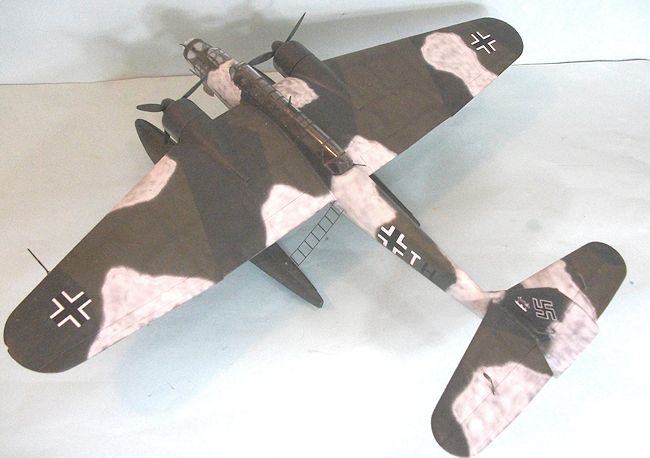 ey were operated by their crews in clandestine operations off Norway, and
later in the Mediterranean.
ey were operated by their crews in clandestine operations off Norway, and
later in the Mediterranean.
The biggest campaign the He-115 took part in was the attack on Convoy PQ-17 in
July 1942. PQ-17, the first
Anglo-American naval operation of the war, consisting of 35 British and American
merchant ships, departed Iceland on June 27, 1942, bound for Archangel.
The Royal Navy provided close escort for the convoy by the First Escort Group
(EG1), under Cdr. J Broome, which included six destroyers, 11 corvettes,
minesweepers or armed trawlers, and two anti- aircraft auxiliaries.
Distant cover was provided by the First Cruiser Squadron, under the
command of Rear Admiral L. H. K. Hamilton, RN.
The four cruisers were the flagship, HMS London, HMS Norfolk,
USS Wichita and USS Tuscaloosa, and four destroyers, two British
and two American. The heavy
covering force, under the command of Admiral John Tovey RN, consisted of the
carrier HMS Victorious, battleship HMS Duke of York, cruisers HMS
Cumberland and HMS Nigeria, the American battleship USS
Washington, and nine destroyers.
The convoy was spotted by the Luftwaffe on July 1.
He-111s and He-115s made the first attack on July 2.
It was expected the convoy could come under attack anytime after July 4.
The heavy force closed on Bear
Island
to provide air support from Victorious.
A single He-115 scored a torpedo hit on the morning of July 4, hitting
the SS Christopher Newport, which had to be scuttled by the escort.
There was an unsuccessful attack in the early evening by six He-115s
which was broken up by USS Wainwright (DD-419).
At this time of year the Arctic had continuous daylight.
Later the same evening, 25 He-111 torpedo bombers sank SS William
Hooper, while losing four shot down.
At the same time, Ultra gave warning that the German battleship Tirpitz
would be deployed against the convoy, in addition to several German air units.
Air reconnaissance of Norway was hampered by poor weather, but it was
confirmed Tirpitz and the cruiser Admiral Hipper had left port.
At 1230 on July 4, Admiral Hamilton was given permission to proceed east of
25 degrees east with his cruisers, should the situation demand, unless contrary
orders were received from Admiral Tovey. This was a reversal of previous orders.
As Tovey had no information that justified this change, Hamilton was ordered to
withdraw when the convoy was east of 25 degrees east, unless the Admiralty
assured him 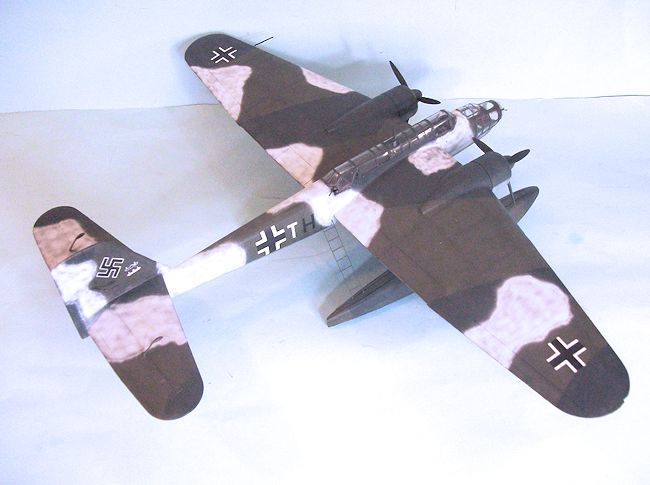
When the order to scatter was received, PQ-17 had covered more than half its
route, losing only three ships. The consequences of the order to scatter were
for the merchantmen. The ships were
now spread over a wide area, stripped of mutual protection as well as trained
escort. The Germans took advantage of this situation.
Within hours, messages on Merchant Navy wavelengths began to be received:
"Am being bombed by a large number of planes", "On fire in the ice", "Abandoning
ship", "Six U-boats approaching on the surface."
Only the close escort of anti-aircraft auxiliaries, corvettes, minesweepers, and
armed trawlers was left to protect the scattered convoy. On July 5, six
merchantmen, including SS Fairfield City, SS Washington, and SS
Daniel Morgan, were sunk by the Luftwaffe with six more by four
U-boats: Commodore Dowding's flagship SS River Afton, SS Pan Kraft,
SS Carlton, SS Honomu, SS Empire Byron and SS Peter Kerr.
Commodore Dowding's refusal to accept defeat was crucial to the rescue of
most of the ships that eventually survived the convoy.
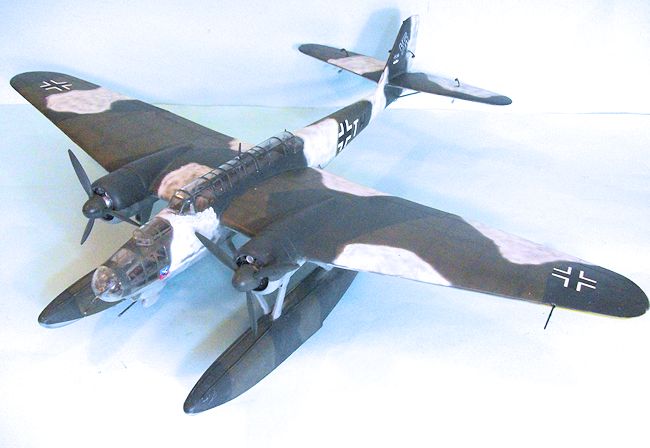
It was now known that it was impossible to send merchant convoys through the
Norwegian Sea in high arctic summer and it was never again attempted.
| CONSTRUCTION |
This
is the first injection-molded plastic kit of the He-115 to appear in 1/48 scale.
It features markings for three aircraft, including the He-115 recently
raised from a Norwegian fjord and undergoing restoration.
I began by assembling the wings and horizontal stabilizers, and then attaching
them to each fuselage half, so that I could work on the joints and thus reduce
gaps and seams. I then painted the
interior RLM Gray,
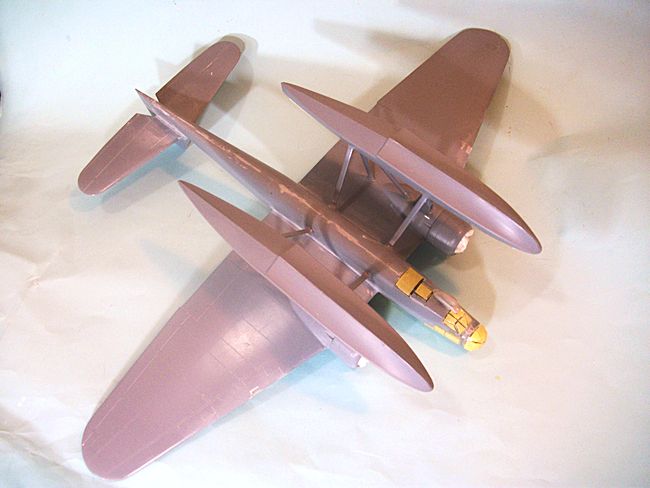 picking out details in semi-gloss black, and assembled the
interior. In retrospect, I should
have attached the large side glass pieces to the nose before further assembly of
the fuselage halves, as this would have resulted in a smoother final fit by
working on it from both sides.
picking out details in semi-gloss black, and assembled the
interior. In retrospect, I should
have attached the large side glass pieces to the nose before further assembly of
the fuselage halves, as this would have resulted in a smoother final fit by
working on it from both sides.
I painted the area of the upper fuselage under the long greenhouse glass with
RLM 72, rather than the RLM 02 that the kit instructions called for, after
finding one upper view of an He-115 in a photo that showed that area the same
color as the exterior. I then
attached the greenhouse, with the pilot's canopy and tail gunner's canopy glued
closed, since they were too thick to pose realistically in the open position.
Masking off the extensive glass paneling took most of an afternoon.
| COLORS & MARKINGS |
I gave the model an overall coat of light grey, then pre-shaded panel lines.
I used Xtracrylix RLM 72, RLM 73 and RLM 65 for the camouflage, obtaining
"hard edge" camo by masking with Tamiya tape.
Once I had taken the tape off, I freehanded the white areas in a ragged
"field applied" manner which approximated some photos.
I unmasked the glass, attached the external gun barrels, the photoetch ladders
and the props.
| CONCLUSIONS |
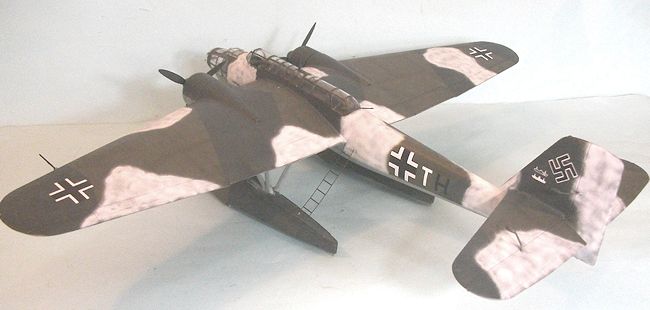 While this model was done very basically out of the box, I have seen two others
by modelers who have put additional work into super-detailing the interiors,
which goes a long way to making a good-looking model.
The He-115 has been a favorite of mine since I saw it crash into Bogie's
cargo ship the first time I saw "Action in the North Atlantic," and I am glad to
see it finally appear in 1/48. The
kit is complex but not complicated, and anyone who has done a few limited-run
kits should have no difficulty creating a nice model for the final result.
While this model was done very basically out of the box, I have seen two others
by modelers who have put additional work into super-detailing the interiors,
which goes a long way to making a good-looking model.
The He-115 has been a favorite of mine since I saw it crash into Bogie's
cargo ship the first time I saw "Action in the North Atlantic," and I am glad to
see it finally appear in 1/48. The
kit is complex but not complicated, and anyone who has done a few limited-run
kits should have no difficulty creating a nice model for the final result.
Tom Cleaver
July 2014
Thanks to HobbyLink Japan for the review kit. Order yours here.
If you would like your product reviewed fairly and fairly quickly, please contact the editor or see other details in the Note to Contributors.